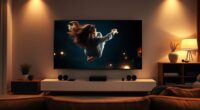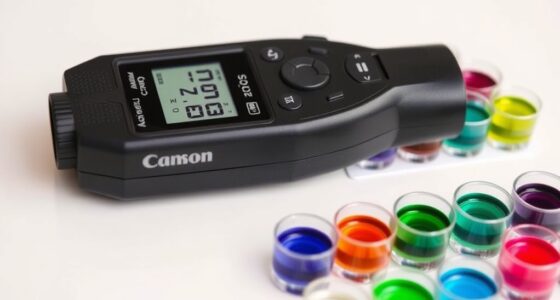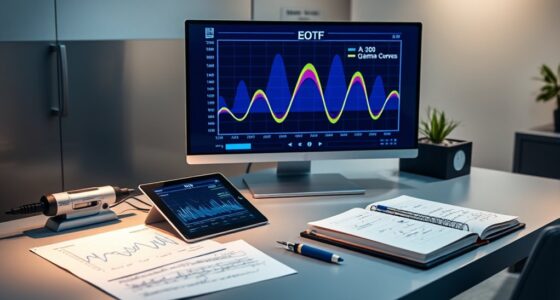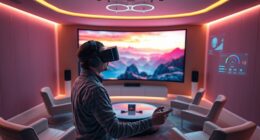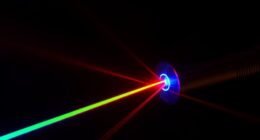To avoid common mistakes in color accuracy and calibration, you need to regularly calibrate your monitor, use consistent color profiles, and control ambient lighting conditions. Don’t rely solely on default settings or outdated profiles, and establish a routine schedule for calibration and maintenance. Selecting the right tools and understanding your hardware limits are also essential. If you follow these tips, you’ll improve your workflows. Keep exploring to discover more strategies for perfecting your color management.
Key Takeaways
- Regularly calibrate monitors and update profiles to maintain accurate and consistent color reproduction.
- Use standardized, embedded color profiles across all devices and software for reliable color management.
- Control ambient lighting conditions to prevent glare and color perception distortions during calibration.
- Schedule routine calibration and monitor device performance to prevent color drift over time.
- Follow proper calibration procedures, choose suitable equipment, and set realistic expectations to ensure optimal results.
Neglecting Proper Monitor Calibration

Neglecting proper monitor calibration can lead to significant color inaccuracies, making your work look different on other devices or in print. Without calibration, your monitor may display colors that are too saturated, dull, or skewed, which hampers your ability to achieve true color consistency. Ambient lighting plays a vital role here; bright or fluctuating light conditions can alter how colors appear on your screen. To avoid this, calibrate your monitor regularly under consistent lighting conditions, ensuring colors are accurate and stable. Proper calibration adjusts your display settings for brightness, contrast, and color balance, helping you maintain precision. Ignoring these steps results in unreliable colors, ultimately affecting your work quality and color management across different platforms.
Using Inconsistent Color Profiles

Using inconsistent color profiles can undermine your efforts to achieve accurate colors, even if your monitor is properly calibrated. When you switch between different applications or devices that use varied color profiles, you risk encountering color profile conflicts and profile mismatch issues. These inconsistencies can cause colors to appear different across platforms, leading to misjudgments in color accuracy. To prevent this, verify all your devices and software are using the same color profile. Regularly verify that profiles are correctly embedded and updated. Additionally, maintaining a consistent color management workflow** helps ensure color fidelity throughout your process. Ensuring that your workflow includes proper profile management minimizes discrepancies and maintains color integrity across all devices and software. Incorporating standardized color profiles across your tools further reduces the risk of conflicts and helps maintain accurate color representation. Implementing monitor calibration routines regularly can also greatly improve overall color consistency. Moreover, understanding the importance of color space compatibility** is essential for avoiding unintended color shifts during editing and output.
Ignoring Ambient Lighting Conditions

Ambient lighting conditions can dramatically impact how colors appear on your screen, yet many overlook this essential factor. The ambient light in your environment influences the perceived color accuracy, making calibration efforts less effective if not accounted for. A bright or uneven lighting environment can wash out colors or introduce glare, skewing your visual judgment. To guarantee accurate color calibration, you must assess and control your ambient light, ideally working in a consistent, neutral lighting environment. Use calibrated light sources or adjust your workspace lighting to minimize reflections and color shifts. Recognizing and managing ambient light is vital for achieving true color accuracy in any professional workflow. Additionally, the presence of discoloration or separation in your environment’s lighting can further distort color perception and calibration results. Ignoring these factors can lead to false color assessments and inconsistent results, undermining your calibration’s reliability. Proper lighting management is essential to maintain consistent color fidelity and avoid calibration errors, especially in environments with variable light conditions. Recognizing and managing ambient light is vital for achieving true color accuracy in any professional workflow.
Overlooking Calibration Frequency and Maintenance

Even if you calibrate your display perfectly today, neglecting regular maintenance can quickly cause colors to drift out of accuracy over time. Without sticking to proper calibration schedules, your monitor’s color fidelity deteriorates, affecting your work quality. Routine maintenance ensures your display stays consistent and reliable. Additionally, environmental factors such as filter effectiveness can influence calibration accuracy and should be monitored regularly. Regularly checking ambient lighting conditions can help maintain optimal color accuracy and prevent calibration issues caused by changing surroundings. Incorporating sensor cleaning methods into your calibration routine can also help reduce eye strain during prolonged editing sessions, ensuring more precise color adjustments. Being aware of potential security vulnerabilities in your calibration tools can help prevent data breaches and ensure your color profiles remain confidential.
Relying Solely on Default Settings

Relying only on default settings can lead to inaccurate colors and poor image quality. You might overlook the importance of manual adjustments and updates that keep your display calibrated. Ignoring these steps can compromise your color accuracy over time. Regularly monitoring display performance helps ensure consistent and accurate color reproduction. Additionally, understanding color management systems can significantly improve calibration results and maintain visual fidelity. Proper calibration also involves understanding how device profiles work within color management workflows. Incorporating calibration tools into your routine can further enhance the precision of your display settings. Being aware of visual perception can help you recognize subtle color discrepancies that affect your overall image quality.
Overlooking Manual Adjustments
Many users assume that default calibration settings are sufficient for accurate color reproduction, but this often leads to poor results. Relying solely on factory presets ignores the importance of manual tweaks and custom adjustments. Without fine-tuning, you miss opportunities to address specific lighting conditions or display peculiarities. Small adjustments can dramatically improve color fidelity and consistency. Additionally, projector bulb maintenance can influence overall image quality, making calibration efforts more effective. Regularly updating calibration profiles ensures sustained color accuracy over time. Proper calibration also involves understanding display calibration techniques to adapt to various environments.
Ignoring Calibration Updates
Default calibration settings can quickly become outdated, causing colors to look dull, inaccurate, or inconsistent over time. Ignoring calibration updates hampers your ability to maintain color accuracy. Regular calibration updates ensure your display’s color profile management stays current, reflecting changes in ambient lighting or hardware drift. Imagine your workspace as a table:
| Before Updates | After Updates |
|---|---|
| Faded colors | Vivid, true hues |
| Inconsistent tones | Balanced color tones |
| Slight color shift | Precise color matching |
| Outdated profiles | Up-to-date profiles |
| Reduced accuracy | Accurate color reproduction |
Additionally, integrating AI-driven calibration tools can help automate and optimize this process for even better results.
Relying on Defaults Only
While sticking to factory settings might seem convenient, it often leads to inaccurate colors and inconsistent image quality. Default settings and preset configurations are designed as starting points, not final solutions. Relying solely on them can cause color shifts, poor calibration, and a lack of consistency across devices. To achieve true color accuracy, you need to customize settings based on your specific environment and workflow.
- Ignoring updates or adjustments can lock you into subpar visual standards.
- Preset configurations rarely account for your unique lighting or display conditions.
- Overconfidence in defaults prevents necessary fine-tuning, risking poor color reproduction.
Failing to Calibrate Devices in the Correct Workflow Order

If you don’t calibrate your devices in the right order, your color accuracy can suffer. The calibration sequence matters because each device depends on the previous step to produce consistent results. Skipping or reversing steps can throw off your entire workflow and lead to incorrect colors.
Calibration Sequence Importance
Proper calibration depends heavily on following the correct workflow order; skipping or misordering steps can lead to inaccurate color results. The calibration sequence ensures each device is aligned properly, preventing color inconsistencies. If you neglect the proper calibration order, you risk compounding errors that affect overall accuracy. Keep in mind that the color sequence matters because each device’s calibration influences the next. For example, calibrating your monitor before your printer can cause color mismatches later. To avoid this, always follow a logical calibration order. Remember:
- The sequence impacts the accuracy of subsequent devices
- Proper workflow minimizes cumulative errors
- Consistency depends on adhering to the correct calibration order
Sticking to the right calibration sequence ensures your color workflow remains precise and reliable.
Device Interdependencies
Failing to calibrate devices in the correct workflow order can cause significant color inconsistencies and undermine your entire calibration process. Devices rely on device synergy, where each component’s calibration affects others. If you skip or misorder calibration steps, you risk creating interdependent calibration issues, where one device’s inaccuracy propagates through the workflow. This can lead to mismatched colors and unreliable results. To prevent this, calibrate devices systematically, starting with the most critical, such as your monitor or scanner, then moving to printers or output devices. Ensuring proper sequence maintains device interdependencies, preserves color accuracy, and guarantees consistent results across your entire workflow. Proper calibration order is essential for achieving reliable, accurate color reproduction.
Choosing Inappropriate Calibration Tools and Software

Choosing the right calibration tools and software is essential because using incompatible or subpar options can lead to inaccurate color reproduction. Poor choices can cause inconsistent results, wasting time and money. When selecting a colorimeter, prioritize proper colorimeter selection to guarantee accuracy and compatibility with your display type. Software compatibility is equally important; mismatched software can limit calibration features or produce unreliable results.
- Guarantee your calibration software supports your device and workflow needs.
- Opt for tools with proven accuracy and reliable performance.
- Regularly update software and firmware to prevent compatibility issues.
Ignoring Color Management in File Workflow

When you ignore color management in your file workflow, inconsistent color profiles can cause your images to look different across devices. Uncalibrated editing software further skews color accuracy, making it harder to achieve consistent results. Addressing these issues is essential to maintain true-to-life colors throughout your projects.
Inconsistent Color Profiles
Inconsistent color profiles often lead to unpredictable results because ignoring proper color management in your file workflow allows colors to shift and appear different across devices and platforms. When you neglect to embed or convert to the correct color profiles, you risk facing color profile conflicts that cause inconsistent color matching. This can result in images looking vibrant on your monitor but dull or off-tone elsewhere. To avoid this, always ensure your files have standardized, calibrated profiles that match your output device. Regularly verify profile consistency across your workflow. Failing to do so can undermine your color accuracy and create costly adjustments later. Remember, consistent color profiles are essential for reliable, predictable color reproduction from start to finish.
Uncalibrated Editing Software
Neglecting to calibrate your editing software can introduce significant color inaccuracies into your workflow. Without proper calibration, your software’s color management might misinterpret color data, leading to inconsistent results. Regular software updates are vital because they often include bug fixes and improvements to color handling, ensuring your workflow remains accurate. Ignoring these updates can cause your user interface to display colors that don’t match the actual output, making it difficult to trust your edits. Additionally, many editing programs lack built-in calibration tools or default settings that support accurate color management out of the box. By neglecting calibration and ignoring software updates, you risk compromising your project’s color fidelity, resulting in images that appear different on various devices or print. Proper calibration is essential for consistent, reliable color accuracy.
Not Testing Across Multiple Devices and Media

Testing your colors on a single device or media type can lead to misleading results because displays and paper types each interpret colors differently. Without testing across multiple devices and media, you risk mismatched colors in the final product, especially when considering device diversity and media compatibility. Different screens and printing surfaces respond uniquely to color profiles, so what looks accurate on one setup may not be on another.
- Use various devices to ensure consistent color appearance across screens
- Test on multiple media types to verify color accuracy in print
- Adjust your calibration based on these diverse results to improve overall consistency
Overlooking the Impact of Hardware Limitations

Have you considered how hardware limitations can distort your color calibration efforts? Hardware constraints, such as display limitations, directly impact color accuracy. Older monitors or inexpensive screens often have limited color gamuts, making it impossible to achieve true color fidelity. Ignoring these display limitations can lead you to believe your calibration is perfect when, in reality, the hardware itself is holding you back. Additionally, many devices lack the precision of professional-grade calibration tools, skewing results. Overlooking these hardware factors risks misjudging your color accuracy. To avoid this mistake, assess your hardware’s capabilities and understand its limitations. Recognize that some inaccuracies stem from the device, not the calibration process. This awareness helps you set realistic expectations and choose suitable equipment for your color-critical projects.
Frequently Asked Questions
How Does Ambient Lighting Affect Color Calibration Accuracy?
Ambient light considerably impacts your color calibration accuracy because it affects your color perception. When ambient light is too bright or uneven, it can distort how you see colors on your screen, leading to inaccurate calibration. To guarantee precise results, you should control ambient light by reducing glare, using neutral lighting, and calibrating in a consistent environment. This way, your calibration remains reliable and true to actual colors.
Can Calibration Tools Improve Consistency Across Different Devices?
Consistent calibration tools can definitely deliver device synchronization and improve color consistency. You’ll find that regular calibration keeps colors crisp and consistent across screens, preventing discrepancies that can distract or mislead. By trusting these tools, you ensure seamless synchronization, saving time and reducing frustration. Proper calibration cultivates confidence in your colors, creating cohesive, engaging visuals that keep your audience engaged and your workflow worry-free.
What Are Common Mistakes When Managing Color Profiles?
One common mistake you make is neglecting proper management of color profiles, leading to conflicts that distort your images. You might also select improper profiles for your devices, causing inconsistent color reproduction. To avoid this, make certain you understand each device’s profile requirements, regularly update and verify profiles, and maintain a consistent calibration routine. This way, you prevent color profile conflicts and improve overall color accuracy in your workflow.
How Often Should Calibration Be Performed for Optimal Results?
Did you know that over 60% of professionals find their color accuracy drifts within just a month? To maintain peak results, you should perform calibration every two to four weeks, depending on your workflow and environment. Setting an ideal scheduling routine ensures consistent color fidelity, reduces costly mistakes, and keeps your work true to life. Regular calibration is vital for achieving accurate, reliable color profiles and maintaining your project’s quality.
Does Hardware Quality Influence Calibration Effectiveness?
Yes, hardware quality considerably influences calibration effectiveness. Hardware limitations, such as outdated or poorly manufactured monitors, can hinder accurate color reproduction even with top calibration software. Investing in high-quality displays ensures that calibration results are more precise and stable over time. Regularly updating calibration software also helps optimize performance, but hardware remains the foundation. Poor hardware quality can cause calibration issues that software alone can’t fully resolve.
Conclusion
If you ignore these common mistakes, your color accuracy will suffer, but did you know that even the best calibration tools can’t fix a poorly managed workflow? Staying vigilant and understanding the science behind color management guarantees your work looks consistent across devices. Think of calibration as a secret weapon—master it, and you’ll access true color perfection. So, don’t just set it and forget it—keep learning, testing, and refining for flawless results.

